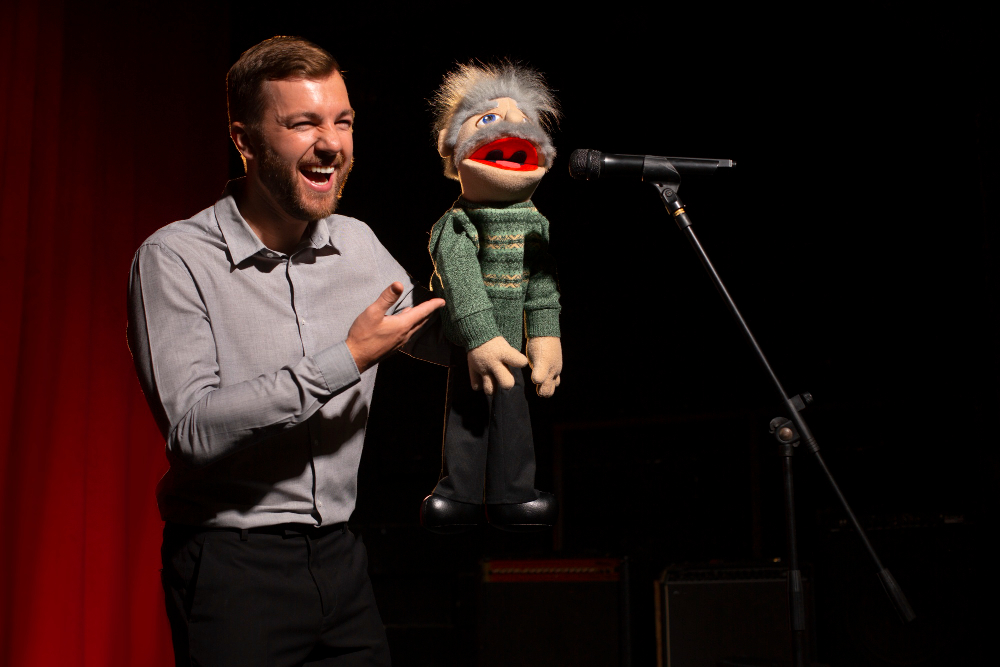Welcome to our blog post on the world of stand-up comedy! In this article, we delve into the art of comedy writing, exploring its intricacies and techniques. We'll discuss the different types of stand-up comedy, from observational humor to topical or prop-based comedy. Then, we'll guide you through the process of creating your own stand-up comedy routine, offering valuable tips on structuring your material and honing your delivery. Additionally, we will explore the essential skills of developing stage presence and timing, ensuring that your jokes land with maximum effect. Finally, we'll provide insights into building a successful stand-up career, offering advice on networking, marketing, and getting gigs. Whether you're a budding comedian or simply a fan of the craft, this post is sure to entertain and enlighten you.

The art of comedy writing is an essential skill for anyone pursuing a career in stand-up comedy. Writing jokes and humorous material requires a unique combination of creativity, wit, and timing. It takes practice and dedication to master the craft of comedy writing, but with the right techniques and mindset, anyone can learn to tickle the funny bone of an audience.
1. Embrace the unexpected: One of the key elements of comedy writing is the element of surprise. The best jokes often take the audience by surprise, presenting a unique perspective or unexpected twist. To cultivate this skill, try thinking outside of the box and consider situations or ideas that challenge conventional thinking.
2. Understand your audience: Knowing your audience is crucial when it comes to comedy writing. Different demographics have different preferences and senses of humor. Take the time to research and understand the audience you will be performing for. Tailoring your jokes to their interests and experiences will greatly enhance the impact of your comedy routine.
3. Use wordplay and puns: Wordplay and puns are a classic tool in comedy writing. Playing with language and cleverly twisting words can create laughs. Incorporate puns into your jokes and explore different ways to word your punchlines. However, it's important to strike a balance and not overuse puns, as it may diminish their comedic effect.
| 5. Collaborate and seek feedback: | 6. Practice and revise: |
|---|---|
|
Collaborating with other comedians or seeking feedback from trusted sources can greatly enhance your comedy writing skills. They can offer fresh perspectives, suggest improvements, and help you refine your material. Be open to constructive criticism and use it to grow as a comedian. |
Comedy writing is a continuous process. It's important to constantly practice and refine your material. Test your jokes in front of different audiences and pay attention to their reactions. Analyze what works and what doesn't, and be willing to revise and adapt your material accordingly. |
Mastering the art of comedy writing is a lifelong journey. By embracing the unexpected, understanding your audience, utilizing wordplay, developing a comedic persona, collaborating with others, and consistently practicing, you can continue to grow as a comedy writer and deliver hilarious and memorable performances.

Stand-up comedy is a unique form of entertainment that has been around for decades. It is a fun and engaging way to make people laugh and take a break from their everyday lives. There are various types of stand-up comedy that performers can choose from, depending on their style, personality, and audience. In this blog post, we will explore some of the different types of stand-up comedy and how they differ from one another.
Observational Comedy: This type of comedy involves comedians making jokes about everyday situations and experiences that the audience can relate to. These comedians often use their keen observation skills to point out the absurdities of life and make humorous observations about them. They may talk about things like relationships, family, work, and social interactions, finding the humor in the mundane.
Physical Comedy: Physical comedy relies on the comedian's body language, facial expressions, and gestures to create humor. Comedians who excel in physical comedy often use slapstick humor, clown-like antics, and exaggerated movements to elicit laughs. They may incorporate funny walks, falls, and silly facial expressions into their routines, making the audience laugh without saying a word.
Character Comedy: In character comedy, comedians create a fictional character or persona to entertain the audience. They fully immerse themselves in the character, using different voices, accents, and mannerisms to bring the character to life. These comedians often perform sketches or monologues as their characters, showcasing their acting skills along with their comedic timing.
Alternative Comedy: Alternative comedy is a style of stand-up that challenges traditional comedy norms. Comedians in this genre often tackle taboo subjects, engage in thought-provoking social commentary, and push boundaries. Alternative comedy can be more surreal, absurd, or satirical, appealing to audiences looking for something different and edgier.
Improvisational Comedy: Improv comedy involves performers creating jokes, scenes, and characters on the spot, without any pre-written material. Comedians in improv shows rely on quick thinking, wit, and teamwork to generate laughs from audience suggestions. This type of comedy is highly interactive and unpredictable, as the performers feed off the audience's energy and responses.
| Type of Stand-Up Comedy | Description |
|---|---|
| Observational Comedy | Making jokes about everyday situations and experiences that the audience can relate to. |
| Physical Comedy | Using body language, facial expressions, and gestures to create humor. |
| Character Comedy | Creating a fictional character or persona to entertain the audience. |
| Alternative Comedy | Challenging traditional comedy norms by tackling taboo subjects and engaging in social commentary. |
| Improvisational Comedy | Creating jokes, scenes, and characters on the spot without any pre-written material. |
These are just a few examples of the many types of stand-up comedy that exist. Many comedians incorporate elements from multiple styles into their routines, creating a unique blend of humor that resonates with their audience. Whether you prefer observational comedy, physical comedy, or any other type, the most important thing is that it makes you laugh and brightens your day.
Creating a stand-up comedy routine involves a lot more than just making people laugh. It requires careful planning, good timing, and a deep understanding of what makes an audience tick. In this blog post, we will dive into the art of creating a stand-up comedy routine and explore some tips and tricks to help you develop your own unique style.
One of the first steps in creating a stand-up comedy routine is to brainstorm ideas for your material. Think about your own experiences, observations, and unique perspectives that can be transformed into funny anecdotes or jokes. Write down anything and everything that comes to mind, even if it seems silly or unrelated. This brainstorming process will help you gather a pool of potential material to work with.
Once you have a list of ideas, it's time to start structuring your routine. This involves arranging your jokes and stories in a way that flows naturally and keeps the audience engaged. One popular approach is the "setup-punchline" format, where you set up a premise or situation in the setup and deliver a funny punchline that catches the audience off guard. Experiment with different joke structures and see what works best for you.
| 1. Know Your Audience |
| 2. Practice, Practice, Practice |
| 3. Use Visuals and Body Language |
| 4. Incorporate Callbacks |
| 5. Edit and Refine Your Material |
When it comes to stand-up comedy, having a strong stage presence and impeccable timing can make or break a performance. Developing these skills takes time and practice, but they are essential for any comedian looking to connect with an audience and deliver funny and memorable performances.
One key aspect of developing stage presence is confidence. It's important to believe in yourself and your material in order to command the attention of the audience. Confidence can be built through rehearsal and performing in front of different audiences, allowing you to refine your delivery and learn what works best.
In addition to confidence, timing is another crucial element of a successful stand-up routine. Knowing when to pause for effect, deliver punchlines, and engage with the audience can take a performance from good to great. Timing can be sharpened through continuous practice, observing other comedians, and studying the rhythm and flow of successful stand-up sets.
| Tips for Developing Stage Presence and Timing |
|---|
| 1. Embrace the stage: Use the entire stage to engage with the audience and make your presence felt. |
| 2. Practice your timing: Experiment with different pausing and delivery techniques to find what works best for your material. |
| 3. Learn from other comedians: Watch live performances and stand-up specials to study the timing and presence of successful comedians. |
| 4. Seek feedback: Perform in front of a supportive audience and ask for their honest feedback to help improve your stage presence and timing. |
Developing stage presence and timing in stand-up comedy is a continuous process. It requires dedication, perseverance, and a willingness to learn from both successes and failures. With consistent practice and honing of these skills, you can become a confident and captivating comedian who leaves a lasting impression on every audience.

Building a successful stand-up comedy career requires a combination of talent, hard work, and dedication. It is not an easy path, but for those who are truly passionate about making people laugh, it can be a rewarding and fulfilling journey. To achieve success in this competitive industry, comedians need to develop their skills, build a strong network, and continuously work on their craft.
First and foremost, successful comedians understand the art of comedy writing. Writing original and funny material is the backbone of any stand-up routine. To engage the audience and leave a lasting impression, comedians must have a unique voice and perspective. They need to brainstorm ideas, test jokes, and refine their material through constant practice and experimentation.
Types of stand-up comedy also play a crucial role in building a successful career. Understanding the different styles, such as observational, anecdotal, or improvisational comedy, allows comedians to diversify their performances and cater to a wider audience. By experimenting with different types of comedy, comedians can find their niche and develop their own distinct style.
In conclusion, building a successful stand-up career requires honing comedy writing skills, experimenting with different types of comedy, creating a well-structured routine, developing stage presence and timing, and building a strong network. While the road to success may be filled with challenges, those who persevere and continue to improve their craft have a greater chance of achieving their goals in the world of stand-up comedy.
| Key Points |
|---|
| 1. Comedy writing is essential for stand-up success |
| 2. Understanding different types of stand-up comedy |
| 3. Creating a well-structured routine |
| 4. Developing stage presence and timing |
| 5. Building a strong network in the comedy industry |